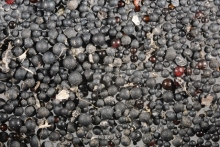Surprising as it sounds, all life forms in the ocean, from small krill to large tuna, seem to obey a simple mathematical law that links an organism’s abundance to its body size. For example, although small krill are individually only about one millionth of the weight of a large tuna, they also tend to be a million times more numerous throughout the oceans. The idea, known as the Sheldon size spectrum theory, was first advanced in the 1970s, but has never been tested for a wide range of marine species and on a global scale until now.


The ocean floor as we know it is dissolving rapidly as a result of human activity.

One of the big mysteries in the scientific world is how the ice sheets of Antarctica formed so rapidly about 34 million years ago, at the boundary between the Eocene and Oligocene epochs.
There are 2 competing theories:
The first explanation is based on global climate change: Scientists have shown that atmospheric carbon dioxide levels declined steadily since the beginning of the Cenozoic Era, 66 million years ago. Once CO2 dropped below a critical threshold, cooler global temperatures allowed the ice sheets of Antarctica to form.

A team of researchers from McGill University and the Quebec government have discovered microplastics (in the form of polyethylene 'microbeads,' less than 2 mm in diameter) widely distributed across the bottom of the St. Lawrence River, the first time such pollutants have been found in freshwater sediments.

The ocean the Titanic sailed through just over 100 years ago was very different from the one we swim in today. Global warming is increasing ocean temperatures and harming marine food webs. Nitrogen run-off from fertilizers is causing coastal dead zones. A McGill-led international research team has now completed the first global study of changes that occurred in a crucial component of ocean chemistry, the nitrogen cycle, at the end of the last ice age. The results of their study confirm that oceans are good at balancing the nitrogen cycle on a global scale. But the data also shows that it is a slow process that may take many centuries, or even millennia, raising worries about the effects of the scale and speed of current changes in the ocean.

